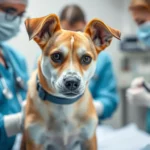
Introduction
Scabs on a dog’s nipples can be a concerning sight for any pet owner. These scabs may appear as crusty patches or raised areas on the skin, signaling potential underlying issues that require attention. It’s crucial to address this problem not only for the comfort of your furry friend but also to prevent any serious health complications.
Understanding the causes, treatments, and when to seek veterinary assistance is essential for every dog owner. This article aims to provide a detailed overview of scabs on your dog’s nipples, empowering you with the knowledge to recognize the signs and take appropriate action.
Understanding Dog Anatomy
Basic Canine Anatomy
A dog’s nipple structure consists of the nipple itself, which is surrounded by sensitive skin. In females, these nipples play an essential role during nursing, but they also have other functions, such as providing sensory input. Male dogs also possess nipples, though they do not serve a functional purpose in terms of nursing.
Differences Between Male and Female Dogs
While both male and female dogs have nipples, there are notable differences in their functionality. Female dogs possess mammary glands that become active during pregnancy and nursing, making their nipples more pronounced and sensitive during these times. In contrast, male dogs have non-functional nipples, but they can still experience health issues, such as infections or trauma.
Common Causes of Scabs on Dog’s Nipples
Allergies
Allergies are one of the most common causes of scabs on a dog’s nipples. These can stem from environmental factors like pollen, dust mites, or chemicals in household products. Food allergies are another possibility, often triggered by ingredients like beef, chicken, or grains. Signs accompanying scabs may include excessive scratching, licking, or redness in the affected area.
Infections
Bacterial and fungal infections can significantly impact a dog’s nipples. Infections may arise from broken skin due to trauma, leading to inflammation and potential scab formation. Signs of infection include redness, swelling, and discharge. If you notice any of these symptoms, it’s important to consult your veterinarian promptly.
Hormonal Changes
Hormonal fluctuations, particularly in female dogs, can contribute to nipple issues. Conditions such as pyometra (a serious uterine infection) or mastitis (inflammation of the mammary glands) can cause scabs or lesions on the nipples. Monitoring your dog for changes in behavior, appetite, or other health indicators is crucial for early detection.
Trauma and Injury
Trauma is another common cause of scabs on a dog’s nipples. Rough play, cuts from sharp objects, or excessive scratching can lead to scab formation. If your dog is an active player or has access to rough terrain, be vigilant for any signs of injury and take preventive measures to minimize risks.
Other Skin Conditions
Various skin conditions can manifest as scabs on a dog’s nipples. Dermatitis, hot spots, and fungal infections can irritate the skin, leading to scab formation. Recognizing these conditions early can help in seeking appropriate treatment and preventing further discomfort for your dog.
Identifying the Symptoms
Physical Signs
Scabs can vary in appearance, ranging from small crusty patches to larger, inflamed areas. You may also observe associated symptoms such as itching, swelling, or redness around the nipples. Pay attention to any changes in the skin’s texture and color to identify potential issues early.
Behavioral Changes
Behavioral changes can often indicate discomfort in your dog. If your pet is excessively licking or scratching at the affected area, it may be a sign of irritation or pain. Other signs to look for include reluctance to play, changes in eating habits, or increased vocalization.
When to Consult a Veterinarian
Signs That Require Immediate Attention
Certain symptoms warrant immediate veterinary attention. If you observe severe swelling, bleeding, or pus around the nipples, it’s crucial to seek veterinary care right away. Additionally, other health indicators such as fever, lethargy, or loss of appetite should not be ignored, as they may indicate a more serious underlying condition.
Recommended Veterinary Diagnostics
When you consult your veterinarian, they will likely conduct a thorough examination of your dog. This may include checking for signs of infection, conducting skin scrapings to identify parasites, or performing allergy testing. Understanding the cause of the scabs is essential for determining the appropriate treatment plan.
Treatment Options
Home Care Solutions
While professional veterinary care is essential for serious conditions, there are some home care solutions you can implement for minor issues. Keeping the affected area clean and dry is vital. Use a mild, pet-safe cleanser to gently wash the area and avoid harsh chemicals. Over-the-counter remedies, such as antiseptic sprays or ointments, may provide relief, but always consult your vet before applying any product.
Veterinary Treatments
For more severe conditions, your veterinarian may prescribe medications to address the underlying issue. This could include antibiotics to treat bacterial infections, antifungal medications for fungal infections, or anti-inflammatory drugs to reduce swelling and discomfort. In extreme cases, surgical options may be necessary to address significant trauma or severe infections.
Prevention Strategies
Regular Health Check-ups
Routine veterinary visits are essential for maintaining your dog’s health. During these check-ups, your vet will examine your dog’s skin, including the nipples, and can identify any potential issues early on. Regular monitoring can help prevent minor problems from escalating into serious conditions.
Maintaining Hygiene
Hygiene plays a crucial role in preventing scabs and other skin issues. Regularly bathing your dog with a gentle, hypoallergenic shampoo can help keep their skin clean and healthy. Additionally, practicing proper grooming techniques, such as brushing your dog’s coat and inspecting their skin regularly, can help identify any potential issues before they become severe.
Diet and Nutrition
A well-balanced diet is essential for maintaining skin health. Foods rich in omega fatty acids, such as fish oil or flaxseed, can improve skin condition and reduce inflammation. Be cautious with food ingredients that may trigger allergies, and consult your veterinarian for personalized dietary recommendations tailored to your dog’s specific needs.
Conclusion
In summary, scabs on your dog’s nipples can be a sign of various underlying conditions, from allergies and infections to trauma and hormonal changes. Recognizing the symptoms and understanding when to seek veterinary help is crucial for your dog’s health and well-being. By maintaining regular health check-ups, ensuring proper hygiene, and providing a balanced diet, you can help prevent this issue and keep your furry companion comfortable and healthy.
FAQs
Can scabs on my dog’s nipples be contagious to other pets?
Scabs themselves are not contagious; however, the underlying causes, such as infections or skin conditions, may be. It’s best to consult your veterinarian for specific guidance.
Are there home remedies for treating scabs?
While some home remedies may provide temporary relief, it’s essential to consult your veterinarian before applying any treatment to ensure it is safe and appropriate for your dog’s condition.
How can I tell if my dog is in pain from this condition?
Signs of pain may include excessive licking or scratching, reluctance to engage in normal activities, vocalization, or changes in appetite. If you suspect your dog is in pain, consult your veterinarian.
What can I do if my dog keeps licking the affected area?
If your dog is persistently licking the area, consider using an Elizabethan collar (cone) to prevent further irritation. Consult your vet for additional advice and treatment options.









